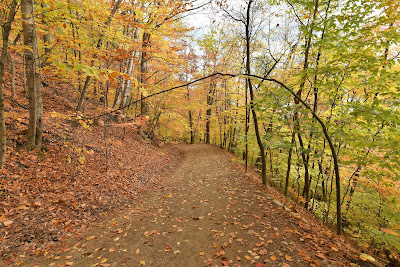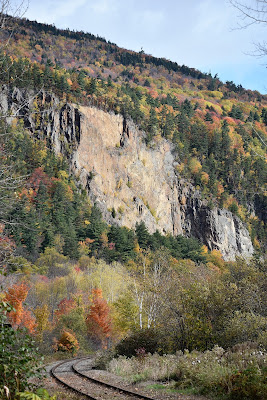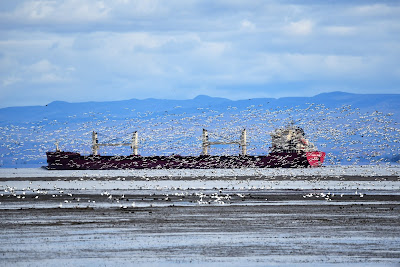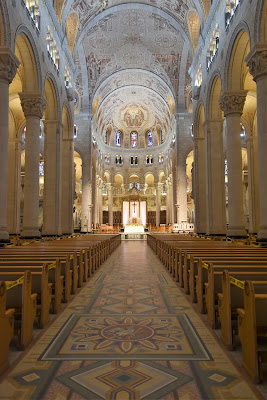Pèlerin d'oiseau : Camp Faille to Saint Anne de Beaupre
When we climbed out of the tent this morning we were greeted by a pale pink sunrise and mostly clear skies. As we made breakfast and packed up the sun peeked over the ridge, setting the yellows, oranges, and reds of the trees ablaze. We couldn't have asked for more spectacular scenery to begin the morning!
The first two kilometers of trail after leaving La Faille involved a very steep climb straight up the side of a mountain. In many places the trail was muddy and wet, and the deep coating of wet leaves made the rocks very slippery. In the most difficult sections there were ropes to help guide us, which we greatly appreciated.
Although the going was tough we kept a pretty steady pace, stopping every once in a while to catch our breath and enjoy the scenery. Much of the slope was covered in sugar maples and American beeches. A carpet of yellow, orange, and red maple leaves crunched beneath our feet while overhead a canopy of coppery beech leaves rustled and shone. We could see the soft blues and greys of the Saint Lawrence through the trees, creating a beautiful contrast with the warm fall colours that surrounded us. Against this backdrop the crisp, bright colours of Blue Jays and Hairy Woodpeckers stood out in stark relief.
Just as we thought we'd reached the end of the strenuous climb, we came to a section of trail that presented a particular challenge to those of us with a fear of heights. We found ourselves skirting around the edge of a steep peak on a series of boulders, below which was a seemingly endless drop to the water's edge far below. As we rock scrambled along, and I frequently found myself either wedged or too short, I was once again left feeling envious of Sean's longer legs and larger reach.
In reality, the crossing probably wasn't as difficult as it seemed with 50 lbs backpacks on, and the view was pretty amazing. As we rounded the peak we looked down past our feet at a large freighter chugging by, surprisingly close to shore in the shallow turquoise waters of the Saint Lawrence. We could also see many shoals and small islands out in the seaway, and as we rounded the bend the sound of hundreds of Snow and Canada Geese suddenly became much louder!
After a few hundred meters of inching across the boulders while trying not to feel like we'd plummet down the slope, we came to a much easier section of trail. We wound our way through stands of spruce and balsam fir, stopping to enjoy the view from several lookout platforms. It was fun to watch American Crows and Bonaparte's Gulls flying by below our lofty perch.
Not too long after this we came to the wooden platform at La Cime, or The Top. This marked the beginning of a new trail section maintained by Environment Canada, which led down into the Cap Tourmente National Wildlife Refuge. At this point the trail got much, much easier to navigate, with wooden staircases, boardwalks, and ropes for assistance on many of the ascents and descents. In most sections the trail bed was relatively level and easy to walk, leaving us free to enjoy our surroundings.
To our delight, as we steadily descended into the wildlife refuge we began to walk through stands of sugar maple, beech, and birch that were still displaying the full glory of their autumn colours. It felt like we were hiking through a glowing golden tunnel, surrounded by sunshine, and we took far too many photos in our excitement.
As we descended we walked along the base of sheer rock walls and cliffs, and squeezed between many tall, mossy boulders. It was an amazing feeling to be so high up, and yet to have the solid rock walls towering above us. The sounds of Black-capped Chickadees, White-breasted Nuthatches, American Goldfinches, and Dark-eyed Juncos filled the trees around us, and the sounds of geese never ceased in the background.
As the trail widened into a track, and then a 3 ft wide trail, and finally into a hard-packed gravel lane way the number of hikers we passed increased exponentially. The last few kilometres of the hike were on the wide treed roadway, but they were extremely steep. Nevertheless, many people were out happily making the huge climb and resting on the prevalent and well-placed benches along the way. There was even a couple with a nearly newborn baby at the top!
Eventually we reached the bottom of the hill we were in the Cap Tourmente National Wildlife Area, which was established in 1978 by Environment and Climate Change Canada. It was created to protect the American bulrush marshes that provide important habitat for the Greater Snow Goose during spring and fall migration periods.
This NWA was recognized as a Wetland of International Significance under the RAMSAR convention in 1981, becoming the first site in North America to earn this distinction. It is also one of more than 100 Important Bird Areas that are found in the province of Quebec. Cap Tourmente is home to more than 180 bird species, 30 mammal species, 700 plant species, and 22 types of forest stands. Many of the species it supports are at risk, including the Peregrine Falcon, Bobolink, and butternut.
The diversity of species this unique area supports is partially due to its unique location at the junction of the Canadian Shield, the St. Lawrence Lowlands, and the Appalachians, as well as at the confluence of the Upper and Fluvial estuaries of the Saint Lawrence.
Although the Sentier Transcanadien simply goes through the Cap Tourmente National Wildlife Area, we took a few hours to explore some of its trails and boardwalks which went by the Visitor's Center and past several wooden bird observatory platforms. The grounds were filled with birders scouring the shrubs, bushes, marshes, and shorelines, and the whole place had a festive atmosphere.
Along the shore we of course spotted thousands of Snow Geese, resting on the sandy shore exposed by the low tide, floating in the water, and filling the air above the waves, so thick they nearly blotted out a freighter passing behind them. They were joined by Mallards, Green-winged Teals, American Black Ducks, Black Scoters, Ring-billed Gulls, Herring Gulls, and likely other species as well. It was amazing to see so much bird life in one spot! While standing there watching the Snow Geese we were reminded how birds connect us all from coast-to-coast-to-coast. A week ago we saw the skies over Saskatchewan come alive with Snow Geese, and we know they are traversing the skies above BC right now. It was truly magical.
From the Observatoire de la Halte-du-Pélèrin we looked up at the cliffs and saw a Peregrine Falcon nest. It was of course empty now, but the adults were spotted in the area and reported on eBird today. We enjoyed reading the information provided in the pavilion on this beautiful bird of prey that was endangered in the 1970's but has made an impressive comeback.
Cap Tourmente is not only rich in natural history, it also contains a number of historically important buildings. The largest of these is the historic farm site, La Petite-Ferme du Cap Tourmente, which was established by Samuel de Champlain in 1626. The farm originally served as a food source for the fledgling community of Quebec City, and later it was run for nearly 300 years by and for the Seminary of Quebec. The farmhouse, which was built in 1667, still stands today and was designated as a National Historic Site of Canada in 2018.
As we passed the National Historic Site the grounds keeper, who was out mowing the lawn, stopped to ask where we were hiking from. We chatted for a bit, and he advised us that there was free camping in Sainte-Anne-de-Bauepré, which was our goal for tonight, but that heavy rain was expected overnight and for tomorrow. We were grateful for his kindness and concern, and his good wishes for the rest of our journey.
As we trekked through the gates, and walked down the grassy trail from the first parking lot to the second we passed two more ponds and their adjacent wetlands. Trails led around the ponds, and there were wooden observatories at the far end. We spotted a Great Blue Heron perched in a willow at the pond's edge, as well as Ring-necked Ducks, Hooded Mergansers, American Coots, Mallards, American Black Ducks, and Northern Pintails floating on the water.
As we left Cap Tourmente we followed the Véloroute Marie-Hélène Prémont. Marie-Hélène Prémont is a Canadian cross-country mountain biker who was born in Quebec City in 1977. She is a 6-time Canadian Champion, an Olympic silver medalist, a Common Wealth gold medalist, and a regular winner at the UCI Mountain Bike World Cup cross country circuit. Throughout the afternoon we were passed by many cyclists who were taking advantage of the beautiful route.
The road we followed is also part of the Route de la Nouvelle France (New France Route). This historical trail links Old Quebec with the Côte-de-Beaupré and traces the route taken by early settlers who delivered their crops to Quebec City. Many structures of historical importance are located along this route, including the colony's first windmill (erected in 1651), many ancestral homes, root cellars, and eight major points of interest, the first of which we reached this afternoon.
As we headed out along the route we passed a small rest area filled with colourful bird houses on poles. How cool is that? There were also picnic tables, garbage cans, a bike rack, and even a water fountain. It felt so good to be part of a culture where hiking, cycling, and the enjoyment of nature are part of the mainstream culture and well-supported by amenities.
The next point of interest was the Village Cap Tourmente, which was announced by a handmade wooden sign. It consisted of a collection of small homes, many of which featured elaborate Halloween decorations on their front lawns. The charming village was situated in a pastoral setting, surrounded by emerald green fields, with rolling and hills and mountains covered in fall colours in the background.
For the next 4 km we hiked through this beautiful and peaceful rural landscape of small farms and country homes. We passed weathered wooden barns, stone farmhouses, white stucco homes with red or wooden shutters, a historical forge, and many more modern homes. The landscape was covered by small fields and farms, with the mountains rising up in the distance. It was an easy walk on the paved road, and we thoroughly enjoyed it.
Eventually we came to the northern edge of Saint-Joachim. This parish municipality was one of the first places to be colonized in New France. It was destroyed in 1629 by the Kirke Brothers, who were adventurers, privateers, and colonial governors, but it became a major agricultural centre again in 1668 when François de Laval bought the land to establish farms to feed his Seminary of Quebec. There is an historical church in the community, but we didn't divert south to visit it.
After Saint-Joachim we walked a sidewalk through more developed residential areas for the next 9 km. It was a mostly pleasant walk, but by the end of it we were ready for a break. We passed by the turnoff for the world renown ski resort at Mont-Sainte-Anne, whose steep slopes we could see rising above the homes lining the road we were following. Apparently these are the highest ski slopes in Eastern Canada.
Another highlight was passing through the community of Beaupré, and crossing the wide, meandering Sainte-Anne-du-Nord River. Allegedly, sailors passing through the region in the early 17th century repeatedly exclaimed "Oh, le beau pré!" or "Oh, the beautiful meadow!" thus giving the community its name. We crossed the river on the road, and then passed the Église Notre-Dame-du-Saint-Rosaire. The church had a unique triangular front with a single steeple that looked quite interesting. However, we passed by just as the adjacent school was letting out, so we didn't linger to take photos.
After hiking just 23 km, we arrived in Saint-Anne-de-Beaupré around 4:30 pm,
feeling like we'd had a full day. As we approached this charming little
community we'd seen the twin steeples of the Basilica of Sainte-Anne-de-Beaupré
from quite a distance, which made us realize that the grain elevators of the
prairies, which have guided us for the last few months of our journey, have
been replaced by church steeples here in Quebec.
The Basilica of Saint-Anne-de-Beaupré is one of the five National Shrines ofCanada, and it is the oldest shrine in North America. Legend says that in 1650 a Breton ship was caught in a storm in perilous waters, and the sailors prayed to Saint Anne, promising to build a shrine in her honour if they were saved. The first shrine was built on the site in 1658, after Étienne de Lessard donated some of his property to the Catholic Church so the chapel to Saint Anne could be built to honour the sailors' promise.
Since it was constructed the Shrine to Saint Anne has been considered a place of healing and miracles for the sick and disabled. It receives over half a million pilgrims each year, and around 40 miracles per year are still attributed to the site. The first of these occurrences was observed during construction of the original chapel. Louis Guimont, who suffered from rheumatoid arthritis, was hired to help build the chapel. After laying three stones, he was apparently cured of all his ailments. Inside the doors of the basilica are two tall pillars with the crutches and other mobility aides of those who have been cured at the site.
The popularity of the site with pilgrims throughout the ages led to several additions and enlargements to the original structure, and in 1876 the first Basilica opened for worship. It was destroyed by fire in 1922, and replaced with the current building in 1926. Work on the steeples and the interior was put on hold during the Great Depression, and only completed in 1946.
When we visited the inside of the basilica we were amazed to discover that much of the inside, including the domed and vaulted ceiling, was decorated with stunning mosaics created from tiny tiles. The ceiling mosaic tells the story of Saint Anne, who was the Virgin Mary's mother, and the grandmother of Jesus. The walls of the basilica were adorned with painted murals, and beautiful stained glass windows ringed the top of the structure, including a colourful and elaborate rose window above the front entrance.
My favorite part of the basilica was all the nature depicted in the artwork throughout. Tiled squares showing biologically accurate birds, insects, mushrooms, and flowers adorned the pillars in the Chapel of the Immaculate Conception underneath the basilica. The wooden pews also had birds, insects, and mammals carved into them, including a star-nosed mole. How cool is that?
Another interesting aspect of the basilica was the statue of Blessed Kateri Tekakwitha, the Iroquois Virgin who died in 1680. Kateri, who was baptized Catherine, and also known as Lily of the Mohawks, is a Catholic Saint who was born a common Algonquin-Mohawk. When she was young she contracted smallpox, which killed the rest of her family and left her face badly scarred. She converted to Catholicism at age nineteen, refused to marry, left her village, and took a vow of virginity. She moved to a Jesuit village south of Montreal, and when she died at age 24, purportedly the scars on her face vanished, leaving her radiant and beautiful looking. She was the fourth Native American to be venerated in the Catholic Church, and the first to be canonized.
As people who have walked three pilgrimage routes across Europe to Santiago de Compostela, following the Camino Frances across Spain, the Via Podiensis across France, and the Camino Portugues across Portugal, we were also delighted find scallop shells depicted in the artwork throughout the basilica. These shells are a symbol of pilgrimage, and have been adopted by many pilgrimage societies around the world, including the Canadian Company of Pilgrims.
After visiting the basilica we walked the stations of the cross, which adorned a steep, forested hill beside the church. Many of the fourteen stations were designed by Émile Roy, who studied sculpture at the School of Fine Arts in Nancy, and they were installed between 1913 and 1945. Saint Anne de Beaupré's Way of the Cross is considered one of the finest in Québec, and it's outdoor location is conducive to meditation. The brilliant fall colours surrounding the statues made the climb very beautiful.
Below the Way of the Cross on the hill was a modest, white stone Commemorative Chapel, which is where the Miraculous Fountain is located. Like Lourdes and other pilgrimage sites, Saint Anne de Beaupré has a freshwater spring that is credited with healing those drink from it. The fountain was built in 1880, and it is protected by a statue of St. Anne in front of the chapel.
Beside the Commemorative Chapel is the Santa Scala, which was built into the hillside in 1891. It is a beautiful white building with rounded archways and balcony railings. Along its side are the Holy Stairs, which pilgrims traditionally ascended on their knees, just as Jesus did for his trial before Pilate in the praetorium. The original stairs are now in Rome.
After exploring the outsides of these buildings, which were all closed, we walked past the Cyclorama de Jerusalem, which is located next to the Saint Anne de Beaupré Shrine. At first the name conjured images of Jesus riding a bicycle, but upon further investigation, the rounded building with its Middle Eastern exterior turned out to have an interesting story. It was a popular tourist attraction since 1895, and inside the building visitors were once encircled by a huge and highly detailed painting that was 14 m high and 110 m around. It showed the city of Jerusalem, Golgotha, the Mount of Olives, the road to Damascus, and the surrounding area on the day that Jesus was crucified. It was designed by Munich painter Bruno Piglhein and executed by Parisian artist Paul Philippoteaux and his four assistants in 1882. It was the only cyclorama in Canada, and is one of the most famous in the world, along with those in Ghettysburg, USA and Waterloo, Belgium. Very sadly the privately owned attraction has been closed due to a lack of funding, and it hasn't been designated a historical site. Hopefully someone can find a way to preserve this unique place!
Before concluding our day we had a mass said for our respective grandmothers and Sean took a moment to visit the healing spring of Saint Anne de Beaupre and to say a prayer for a younger relative. Sometimes when you have tried everything else, all you can do is sit in silence and pray - for help and the strength to continue on.
We ended our explorations with a visit to the Apollo Café, where we had cups of
strong, hot coffee, delicious peanut butter, oat, and chocolate cookies, and
peanut cocoa balls.
It was a wonderful way to end a day that had brought us from a wild, rugged mountain peak, to a National Wildlife Refuge, to a pilgrimage site that was rich in history. This is one of the many days on the Sentier Transcanadien that makes us realize what a privilege it is to walk across Canada.
See you on the trail!
Remember to follow our entire adventure here : www.comewalkwithus.online






































































































Comments
Post a Comment